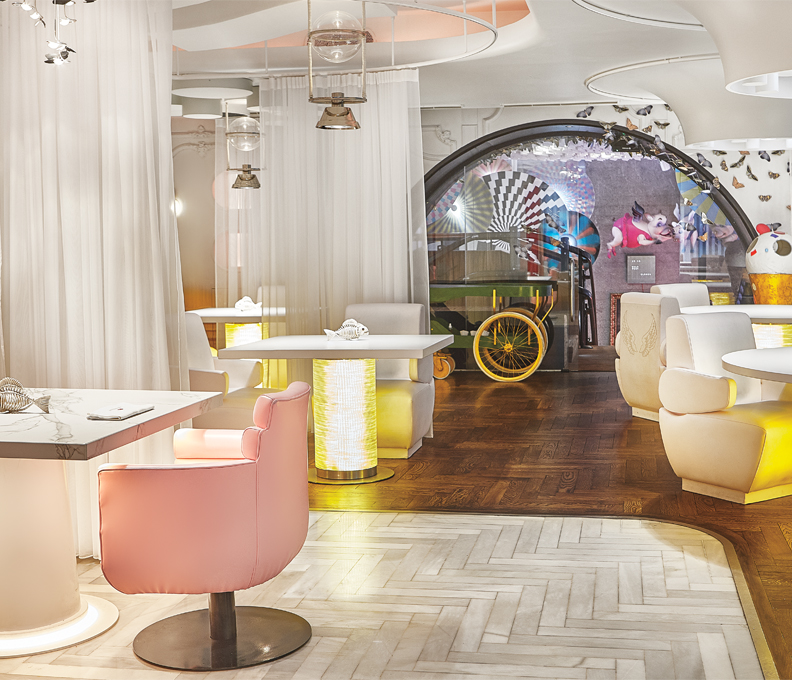Consumer demand
September 30, 2016

The China anti-corruption campaign may have seen an end to ostentatious ordering of auspiciously priced bottles of $8,888 Lafite, and grand banquets with endless courses of exotic fare, but for people at the slightly less-rarefied end of the Beijing wining and dining spectrum, the choices are widening by the day.
The engine driving the city’s restaurant and hotel growth is the Chinese middle class – the affluent, white-collar segment of society that has traveled overseas, sampled fine-dining restaurants and stayed in posh hotels. Visit any restaurant in Beijing these days and most of the people perusing the sushi menu or studying the wine list will be locals rather than expats or foreign visitors on expense accounts.
Likewise, the main revenue driver of the high-end hotel trade is, increasingly, executives on business trips to the capital from Shanghai, Shenzhen or Shenyang.
“We have seen the unleashing of the Chinese consumer,” says Michael Faulkner, general manager of luxury hotel East Beijing, who has lived in the city for seven years. “Traveling overseas has opened their eyes to new food styles and design, and you can see trends emerging from that such as eating organic produce. The dynamic changes are very fast and you have to be flexible in terms of menu items and service style.”
All of this is great news for the estimated four million annual overseas visitors to Beijing, who can pick from an ever-increasing choice of upmarket places to stay and independent restaurants aspiring to London, Paris and New York standards.
Hotels
The most significant recent opening has been the 283-room Rosewood Beijing, a downtown property that arrived in October 2014, earning instant gold-medal status from travelers. The location helps – directly opposite the CCTV Tower and a short stroll from the central business district – as do the generous rooms – over 500 square feet for entry-level accommodations. The wide range of enticing restaurants include the rustic Country Kitchen, with its gourmet updating of traditional peasant dishes and fruitwood-roasted Peking duck.
It will be a hard act to follow for a number of new hotels – and revamped old-timers – that are set to join the fray in the next year or so. The first of these was the 303-room Intercontinental Beijing Sanlitun, which opened in August. The hotel boasts spiffy location in Sanlitun, a buzzing district that’s home to scores of bars, restaurants and boutiques.
In-house the options include tapas, Chinese and Japanese eateries and a bar specializing in whisky and beer. The hotel occupies the first 23 floors of a 38-story tower. The only other five-star residence of note in the immediate area is the trendy 99-room Opposite House, a favorite of the fashion and design crowd.
Art is one of the dominant themes of Nuo, opened in June last year, the first hotel from a Chinese state-run group with global aspirations. That grand ambition is reflected in the capacious lobby area, with its oversized Ming dynasty-inspired porcelain jars. The 438-room hotel has its own art gallery and is within easy reach of the 798 Art Zone, now one of the city’s top ten attractions.
Nuo is aiming for the luxury end of the market, in particular well-heeled Chinese travelers. The ultimate aim is that there will be Nuo properties in major international cities, which are designed and operated with Chinese sensibilities in mind.
A hotel group that has been mixing and matching the best of China and the West for many years is the Peninsula. The Hong Kong-based company’s Beijing outpost, a short stroll away from Tiananmen Square, was the first genuine five-star in Beijing when it made its debut two decades ago, but the grand hotel has begun to look its age in recent years.
A radical approach to refurbishment has been undertaken, with the number of rooms more than halved, to 230. The first batch – available in August – are a minimum 640 square feet; other changes include an expanded lobby and a lighter, brighter color scheme. The renovations are to be fully complete early next year.
Other high-end properties scheduled to open include the long-delayed, 241-room Mandarin Oriental in the fire-afflicted, yet-to-open building next to the CCTV Tower. A second boutique property, the 74-room Mandarin Oriental Wangfujing, is set to open in 2017 in a new, mixed-use complex. Next year will also see the debut of the 120-room Bulgari in the embassy area, north of the Sanlitun nightlife zone.
Restaurants
For all the razzle-dazzle newness in Beijing, two of the most significant restaurants to open of late are located in quiet historical zones, far from the soaring skyscrapers and car-clogged freeways that have come to symbolize modern Beijing.
TRB Bites at the Courtyard (trb-bites.com) is the latest venture by Belgian entrepreneur Ignace Lecleir, the city’s go-to guy for fine-dining in heritage surroundings. TRB Bites is located in a three-story building on the eastern edge of the Forbidden City’s moat, offering glorious views over the water towards the imposing vermilion walls. It is less complicated than Lecleir’s gourmet venue, TRB (Temple Restaurant Beijing), serving set menus that might include a choice of pork loin with mustard seeds, squid with cauliflower purée, or pork with purple potato. The upper-level Sky Room or lower-level Water Room offer private dining options.
Another notable newcomer is the Georg (thegeorg.com) by Georg Jensen, where visitors can browse the showrooms of the lifestyle company before enjoying a meal in the restaurant. The Georg is located in a quaint part of the city, next to the Jade River, and offers Scandinavian-influenced dishes such as grilled parsnip with squid and black garlic, duck breast with beetroot and potato cream, and slow-cooked short rib with carrot and turnip. Diners can opt to sit in the amply spaced main room or a private dining space.
Okra (okraworks.com), the Japanese-style restaurant operated by US chef Max Levy, is a smaller space but with a large and dedicated following among Beijing foodies. Located in “1949 The Hidden City” – Sanlitun’s dining and entertainment complex – Okra’s emphasis is on quality and originality, featuring a dish where the eel-preparation process takes three whole days, fish-head teriyaki, salted pork belly and dry-aged wagyu beef rib.
Bars
Another welcome addition to Beijing’s after-work scene is the new breed of craft-ale bars. Also within 1949 The Hidden City is Jing A (capitalbrew.com), which serves a wide range of brews. Among them are Worker’s Pale Ale, Flying Fist IPA and the extra-strong Airpocalypse Double IPA, dedicated to the city’s notoriously awful pollution; when the foul-air index rises, the price of the beer goes down.
The godfather of the city’s craft-ale scene is American Carl Setzer, who now has three branches of Great Leap Brewing (greatleapbrewing.com), where up to 20 options are on tap at any one time. The flagship offering is Honey Ma Gold, a beer made with Sichuan peppercorn. Other distinctively named ales are Liu the Brave Stout, Dubbel Happinessand Cinnamon Rock Ale, brewed with Vietnamese cinnamon and Chinese rock candy.
Two of the three Great Leap Brewing outlets are on the fringes of the Sanlitun nightlife zone, and serve hearty and tasty pub food. Another popular brewpub, Slowboat (slowboatbrewery.com), operates in a traditional leafy hutong (alleyway), not far from Lama Temple.
A guided tap-room tour is offered by Bespoke Travel Company. Founded by long-term resident Sarah Keenlyside, it specializes in quirky tours. Choose from motorbike-and-sidecar tours, electric scooter expeditions and Great Wall walks with historians, as well as unusual venues for meetings. There’s no shortage of ways to impress clients in Beijing these days.




